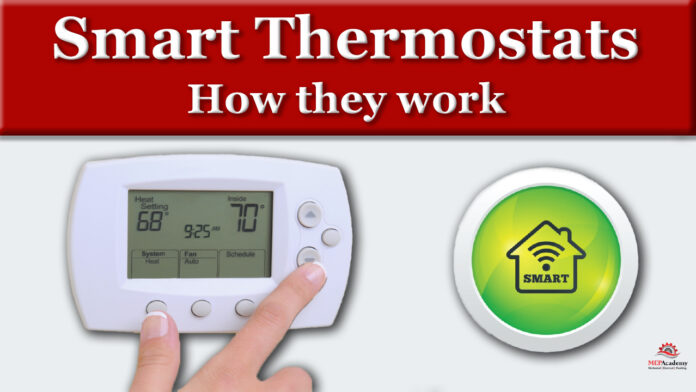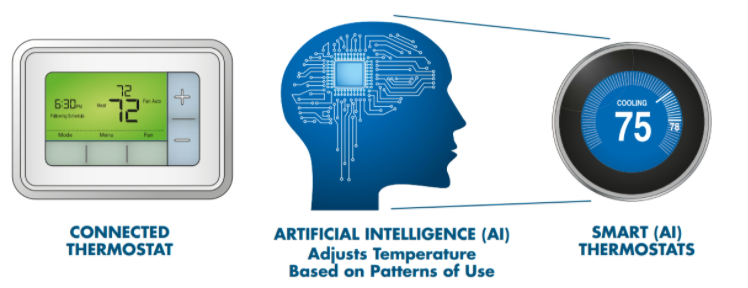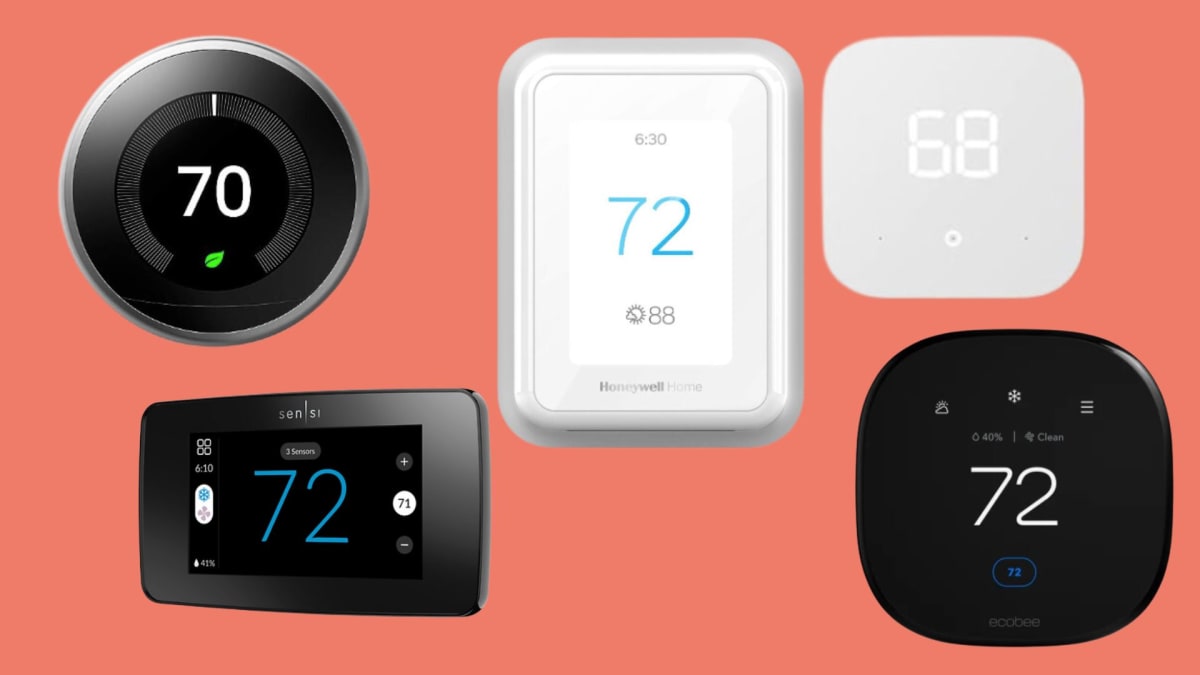A Smart Thermostat Can Accomplish Which Of The Following

Unlocking Home Comfort: What Can a Smart Thermostat Really Do?
Are you tired of manually adjusting your thermostat? Do you dream of a more energy-efficient home? A smart thermostat might be the answer. These devices go far beyond simply setting a temperature. They offer a range of features designed to improve comfort, save money, and provide you with greater control over your home's climate. But what can a smart thermostat *really* accomplish? Let's dive into the capabilities, benefits, and limitations of these modern marvels.
Beyond the Basics: Core Features of a Smart Thermostat
At its heart, a smart thermostat is still a thermostat. However, it offers significantly more than just temperature control. Here are some of the fundamental features:
- Remote Control: Adjust your thermostat from anywhere with an internet connection using your smartphone, tablet, or computer. Imagine preheating your home before you arrive or turning down the heat if you forgot before leaving on vacation.
- Programmable Schedules: Set different temperatures for different times of day and days of the week. This allows you to optimize energy usage based on your routine. No more heating or cooling an empty house!
- Learning Capabilities: Some smart thermostats can learn your habits and preferences over time, automatically adjusting the temperature to suit your needs without requiring manual programming.
- Geofencing: Using your smartphone's location, the thermostat can automatically adjust the temperature when you leave or approach your home. This ensures optimal comfort and energy savings.
- Energy Reports: Track your energy consumption and identify areas where you can save money. Smart thermostats provide detailed reports on your heating and cooling patterns.
- Integration with Other Smart Home Devices: Connect your thermostat to other smart home devices, such as smart lights and door locks, for a more integrated and automated experience.
Boosting Efficiency: How Smart Thermostats Save You Money
One of the biggest draws of a smart thermostat is its potential to save you money on your energy bills. Here's how:
- Reduced Energy Waste: By automatically adjusting the temperature based on occupancy and schedules, smart thermostats minimize wasted energy.
- Optimized Heating and Cooling: Learning capabilities and geofencing ensure your HVAC system only runs when needed, avoiding unnecessary energy consumption.
- Early Detection of Problems: Some smart thermostats can detect unusual HVAC behavior, such as excessive run times, which could indicate a problem with your system. Addressing these issues early can prevent costly repairs down the line.
- Incentive Programs: Many utility companies offer rebates and incentives for installing smart thermostats, further reducing the initial cost.
Pro Tip: To maximize your energy savings, be sure to properly configure your smart thermostat's settings and take advantage of its advanced features like geofencing and scheduling.
Diagnosing Problems: Can a Smart Thermostat Help You Troubleshoot?
While a smart thermostat isn't a substitute for a qualified HVAC technician, it *can* provide valuable insights into your system's performance and potentially help you diagnose some common issues. Look for these clues:
- Unusual Run Times: If your thermostat is constantly running, it could indicate a problem with your HVAC system, such as a refrigerant leak or a malfunctioning compressor.
- Temperature Discrepancies: If the temperature displayed on your thermostat doesn't match the actual temperature in your home, it could indicate a sensor issue or a problem with your HVAC system's airflow.
- Error Messages: Some smart thermostats display error messages that can help you identify specific problems, such as a faulty sensor or a communication issue with your HVAC system.
Important Safety Note: Never attempt to repair any electrical components of your HVAC system unless you are a qualified and licensed electrician. Working with electricity can be dangerous and potentially fatal.
DIY vs. Calling a Professional: Knowing Your Limits
While installing a smart thermostat is often a straightforward DIY project, some situations require the expertise of a qualified HVAC technician. Here's a guide to help you determine whether to tackle a task yourself or call for professional help:
DIY-Friendly Tasks:
- Replacing an Existing Thermostat: This is typically a simple process that involves disconnecting the old thermostat, connecting the wires to the new thermostat, and mounting the new thermostat on the wall. Always turn off the power at the breaker before working with electrical wires.
- Connecting to Wi-Fi: Following the manufacturer's instructions to connect your smart thermostat to your home Wi-Fi network.
- Basic Troubleshooting: Checking wiring connections, restarting the thermostat, and consulting the user manual for common issues.
When to Call a Professional:
- Wiring Issues: If you are unsure about the wiring of your thermostat or if you encounter any damaged or corroded wires, it's best to call a professional.
- HVAC System Problems: If your smart thermostat is displaying error messages that indicate a problem with your HVAC system, such as a refrigerant leak or a malfunctioning compressor, you should call a qualified HVAC technician.
- Complex Configurations: If you have a complex HVAC system, such as a multi-zone system or a heat pump, you may need professional help to properly configure your smart thermostat.
- Lack of Confidence: If you are uncomfortable working with electricity or if you are unsure about any aspect of the installation process, it's always best to err on the side of caution and call a professional.
Warning: Incorrect wiring or improper installation can damage your HVAC system or create a safety hazard. If you're not confident in your abilities, always consult a professional.
Estimated Costs: What to Expect
The cost of a smart thermostat can vary depending on the features and brand. Here's a general breakdown:
- Smart Thermostat: $100 - $300+ (depending on features)
- Professional Installation (if needed): $100 - $300 (depending on complexity)
Important Note: These are just estimates. The actual cost may vary depending on your location, the specific thermostat you choose, and the complexity of the installation.
Troubleshooting Common Smart Thermostat Issues
Even with the best smart thermostat, you might encounter some common issues. Here's how to troubleshoot them:
- Thermostat Not Connecting to Wi-Fi:
- Check Your Wi-Fi Password: Ensure you're entering the correct password.
- Restart Your Router: Power cycle your router to refresh the connection.
- Check Wi-Fi Signal Strength: Make sure the thermostat is within range of your Wi-Fi router.
- Consult the User Manual: Follow the manufacturer's instructions for troubleshooting Wi-Fi connectivity issues.
- Thermostat Not Controlling Temperature:
- Check Wiring Connections: Ensure all wires are securely connected to the correct terminals.
- Verify Thermostat Settings: Make sure the thermostat is set to the correct mode (heat or cool) and temperature.
- Check for HVAC System Problems: As mentioned earlier, unusual run times or temperature discrepancies could indicate a problem with your HVAC system.
- Thermostat Not Displaying Correct Temperature:
- Recalibrate the Thermostat: Some smart thermostats allow you to manually recalibrate the temperature sensor. Consult the user manual for instructions.
- Check for Obstructions: Make sure the thermostat is not blocked by furniture or other objects that could affect its temperature readings.
Tools and Parts You Might Need
If you decide to tackle a smart thermostat installation yourself, here are some tools and parts you might need:
- Screwdriver Set: Including Phillips head and flat head screwdrivers.
- Wire Strippers/Cutters: For stripping and cutting electrical wires.
- Pencil: For marking screw locations.
- Level: To ensure the thermostat is mounted straight.
- Drill (optional): For drilling pilot holes in drywall.
- Wire Connectors (optional): For connecting wires.
- Voltage Tester (optional): To verify that the power is off before working with electrical wires. Always use caution!
Conclusion: Embracing Smart Home Comfort
A smart thermostat can be a valuable addition to any home, offering improved comfort, energy savings, and greater control over your HVAC system. By understanding its capabilities and limitations, you can make an informed decision about whether a smart thermostat is right for you. Remember to prioritize safety and consult a qualified professional when needed. With the right approach, you can unlock the full potential of your smart thermostat and enjoy a more comfortable and energy-efficient home. Consider a smart thermostat if you want enhanced control over your environment. A good smart thermostat can save you money. And always remember, safety first!










